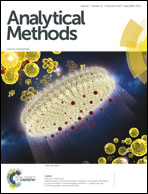A novel and highly sensitive electrochemical sensor based on a high-quality modified graphene electrode for the determination of hydrochlorothiazide in pharmaceutical formulations and human plasma
Abstract
This study is concerned with the development of a practical, efficient and highly sensitive electrochemical sensor for the determination of hydrochlorothiazide (HCT) in pharmaceutical dosage forms or clinical samples using a high-quality modified graphene electrode (H-GRE) which has recently emerged as a very promising material for sensor applications. High-quality graphene (H-GR) was synthesized efficiently by a single-step reduction method from graphene oxide (GO). It was characterized by Fourier transform infrared spectroscopy (FT-IR), X-ray diffraction (XRD) and transmission electron spectroscopy (TEM). The electrochemical behavior of HCT was investigated using adsorptive stripping differential pulse voltammetry on the H-GRE. The H-GRE showed excellent electrochemical activity for the oxidation of HCT. Under the optimized experimental conditions, the linear response range of HCT was found to be 0.1–48.0 μM with a detection limit (based on S/N = 3) of 19 nM. This improved electrode may provide a promising alternative sensor for the determination of HCT in pharmaceutical formulations and clinical samples.


 Please wait while we load your content...
Please wait while we load your content...